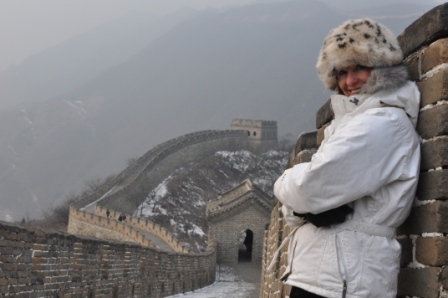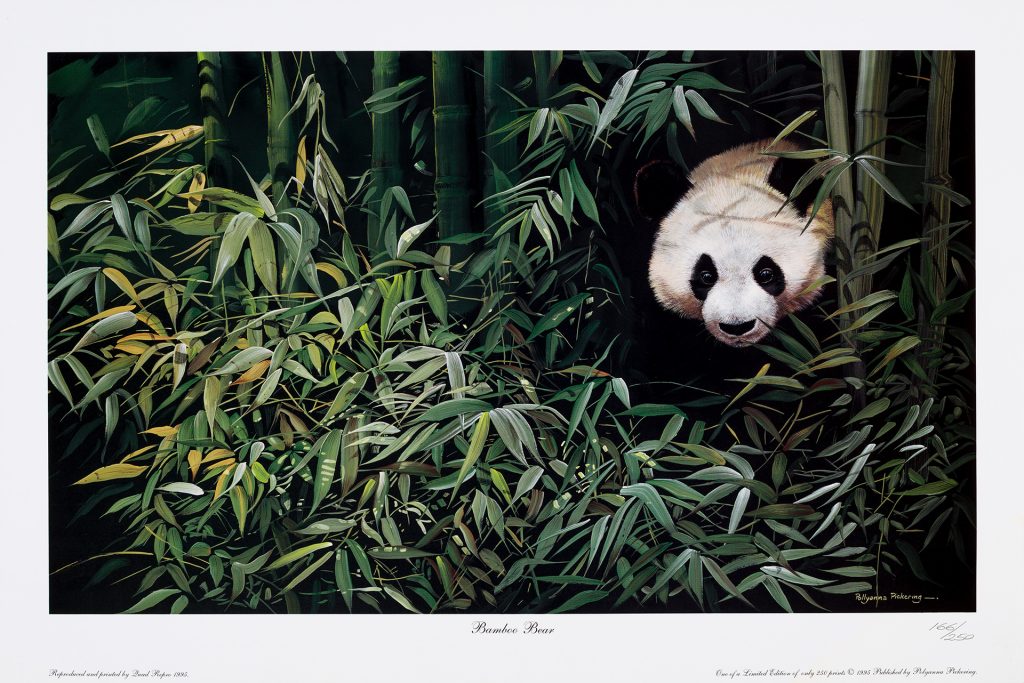Beyond the Great Wall
In January 2010 Pollyanna made her first return journey to China in fifteen years, travelling far beyond the legendary Great Wall in search of some of the country’s most endangered species.
A major exhibition of fifty new original paintings inspired by this, and her previous journey, was staged for the first time in her private gallery19th June – 4th July 2010.
Initially Pollyanna braved temperatures as low as -29º, journeying to the rarely visited extreme North East corner of China. Wild Siberian Tigers have been sighted in the Hunchun Nature Reserve in the transborder area between Russia and China which provides a ‘corridor’ of habitat so tigers can disperse from Russia and repopulate areas of China where they once lived.
Poaching of tigers for traditional Chinese medicine, along with over-hunting of their prey species, wiped out populations in China. Yet much of their habitat remained intact, and in 2003 an adult tiger was photographed for the first time by a remote camera, operated by the Wildlife Conservation Society who established the reserve. However research suggests that fewer than 20 of the tigers exist in the wild in China, and despite spending days in the region, the tigers proved elusive, and Pollyanna was not able to sketch one in the wild – although she was rewarded with wonderful sightings of other wildlife who share the tiger’s habitat including deer, cranes, eagles and rough legged hawks.

Pollyanna was able to sketch the tigers in a breeding and conservation centre established to create a pool of Amur tigers with a pure genetic bloodline, with the eventual aim of re-introducing the cats into this remote mountainous region which they once roamed in large numbers. For five days, Pollyanna spent eight hours a day in a vehicle inside their huge compounds observing and sketching the magnificent cats. “It was a unique opportunity to watch Amur Tigers in their natural habitat” Pollyanna commented “I was able to sketch as they interacted with one another, and I gained so much inspiration for new paintings in . these surroundings. Seeing first hand the way the snow lays on their fur, or becomes encrusted on their feet and tails will enable me to paint the tigers in the snow with a realism and accuracy which would have been completely lacking if I hadn’t made this expedition.”
2010 is the Chinese Year of the Tiger, and Pollyanna is proud to be able to present her latest collection of paintings during this auspicious year! Chinese horoscopes for the year predict change and travel – and a vigorous and hard-working year ahead. In the Chinese Zodiac the tiger . symbolises support and care, and through the exhibition Pollyanna hopes to raise funds to support the protection and conservation of wildlife in this remarkable country.
The most iconic animal to be found in China is of course the Giant Panda – designated a ‘National Treasure’ by the Chinese Government. Fifteen years ago Pollyanna and her daughter Anna-Louise were the first two western women ever to travel to a remote panda reserve in the Tibetan Borderlands of China. Here they worked in a small panda hospital, helping to care for a six month old baby panda bear – and in the surrounding mountains succeeded in seeing a wild Giant Panda. Since then the Earthquake which struck the Sichuan Province in 2008 has devastated the region, with many of the roads yet to be rebuilt. During her first journey, Pollyanna also visited the panda breeding and conservation centre at Wolong, which suffered so much devastation during the quake that it will not be rebuilt. In fact the epicentre was just a few miles from Wolong, and aftershocks continued for days. In a 24 hour period, 178 aftershocks were monitored in the quake zone.
This time Pollyanna followed in her original footsteps to the starting point of her journey – the city of Chengdu – where she spent a day at the The Giant Panda Breeding Research Base sketching the residents, including the beautiful red pandas. However her main destination was The BiFengxia Giant Panda Base. Originally planned and built as a ‘training’ centre to prepare captive bred pandas for release into the wild, since the devastating earthquake it has provided sanctuary for 53 pandas relocated from the centre at Wolong. Interestingly, survivors of the earthquake said afterwards that the pandas seemed to know the disaster was imminent, commenting that the pandas stopped eating bamboo and became eerily agitated moments before the quake struck.
The conservation centre is situated at the edge of BiFengXia Gorge – an area of outstanding natural beauty 1,200 meters above sea level. Each panda enclosure covers at least 1,000 square meters – nine times bigger than the pens in Wolong. Several different varieties of bamboo have been planted on the mountain slopes. Pollyanna was fortunate enough to be allowed to work closely with the pandas, even sitting quietly inside their enclosures with her sketch pad. On occasion a panda – such as Ning Ning (above) would wander up to have a look at this unexpected visitor. “It was such a privilege to be so close to these beautiful creatures” Pollyanna said. “Although they could, if they wished, severely injure a human being, they are so gentle and placid. I think they must be the cutest animals ever created – with their black eyes shining out of two huge black patches of fur, and their perfectly round teddy-bear ears. I am sure very few wildlife artists have ever had the opportunity to get so close to one of the most endangered and enigmatic creatures in the world!”
Although the diet of a wild panda consists entirely of bamboo, in the centre as the cubs are weaned their diet is sometimes supplemented with other fruit and vegetables. Ning Ning is especially partial to apples! Pandas eat for up to 14 hours a day, and spend the rest of the time sleeping. Since the pandas’ digestive system is not very efficient, they must consume large quantities of bamboo every day, in order to obtain the nutrition they need. Between the ages of 12 months and 18 months, a panda cub will gain nearly 100 pounds and grow the strong teeth it needs to eat bamboo. At this young age Ning Ning is still playful and inquisitive!
Ning Ning was one of the first cubs to be born after the earthquake, bringing fresh hope to the breeding and re-introduction programme. One of twins, he was born on the 27th July 2008. His name is a diminutive version of Nanjing – the town of the same name christened him during a ‘Ceremony of Thanks’ which celebrated the birth of the new cubs, and pledged their support for the pandas.
Bile Bear Rescue
While in China, Pollyanna also took the opportunity to visit a wonderful sanctuary for Asiatic Moon Bears rescued from the unspeakably cruel bile bear industry, and now given a home in a wonderful facility created by the Animals Asia Foundation. In countries across Asia, thousands of bears live a life of torture on bear farms, so that their bile can be extracted and used in traditional medicine. Bears are confined in cages which vary from agonisingly tiny “crush” cages to larger pens, all of which cause terrible physical and mental suffering. Pollyanna was invited to visit the centre by Jill Robinson the founder of the charity, who has dedicated her life to improving the plight of animals in the region.
Ten percent of sales made during the exhibition were donated through the Pollyanna Pickering Foundation, helping to raise £5200.00 to finance the complete rescue and transfer of a moon bear into the sanctuary. Click Here to Read About the Rescue
Any additional funds raised will go to funding the Naturewatch Spotlight on China Campaign. Pollyanna is a patron of Naturewatch, and has given her backing to this ambitious campaign – with the ultimate goal being to help the Chinese authorities introduce and enforce animal welfare laws for the purpose of protecting domestic, farmed and captive animals in China.












